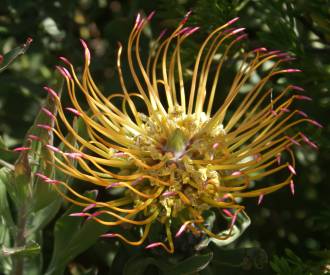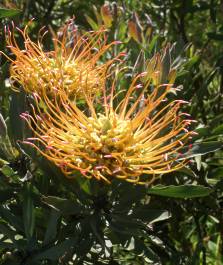Leucospermum catherinae
Leucospermum catherinae Compton
Family: Proteaceae
Common names: catherine-wheel pincushion (Eng.)
Introduction
The catherine-wheel pincushion is amongst the most spectacular of the "firework pincushions", making an attractive display when in full flower.

Description
Description
An evergreen, erect shrub up to 3 m, spreading with age, growing from a single main stem at the base. The leaves are hairy becoming leathery grey-green when mature. They are 90-130 mm long and 10-25 mm wide with 3 or 4 teeth; alternate, with a distinct stalk. The inflorescences are large, up to 150 mm in diameter and are usually found as a single orange flower head turning coppery bronze when mature. They flower from spring to early summer (September to December). The seeds (technically fruits) are relatively hard-shelled hairless nuts. The plants mature rapidly and will flower by their third year and start dying off naturally after 10 years.
Conservation Status
Status
Their Red List status of Endangered is mainly due to a naturally small, fragmented sub-population size in the wild. Overgrazing by cattle in the plants' natural habitat and an incorrect fire regime of too frequent or too few fires may also be detrimental.

Distribution and habitat
Distribution description
Their natural distribution extends from Middelberg in the Cederberg, southwards to the Koue Bokkeveld and Ceres mountains with outlying populations in Piketberg. Large stands are seldom encountered as most populations are small, consisting only of a few individuals, while solitary, widely dispersed plants are not unusual.
Leucospermum catherinae grows in a Mediterranean climate with an average winter rainfall of over 1000 mm a year. Summers are hot and winters may reach 0°C. The most favoured habitats of L. catherinae are level flats of coarse sand derived from weathered Table Mountain sandstone in mountain fynbos along seepage areas at elevations varying from 650-1300 m above sea level. Very occasionally small groups are found on drier rocky slopes.
Derivation of name and historical aspects
History
The genus Leucospermum is named from the Greek leukos meaning white, and sperma seed, referring to the white seeds of many species. The specific name catherinae was chosen partly because of the wheel-like appearance of the flower heads and partly to honour the name of Mrs. Catherine van der Byl who provided Professor Compton with information regarding the location of wild populations of this species.
There are around 50 species of Leucospermum, mainly in the southwestern and southern regions of the Western Cape, but extending to the Eastern Cape, KwaZulu-Natal and Zimbabwe.
Ecology
Ecology
Bees frequent these attractive flower heads but don't effect pollination. They are also visited by sunbirds and sugarbirds, which are the pollinators. The birds perch on the flowerheads, and probe into the flowers in search of nectar and in so doing their heads or necks come into contact with the pollen presenters and stigmas at the tips of the styles.
The fruits ripen in summer after 6-8 weeks and are released immediately to the ground where they are collected by ants and stored in their nests. In doing so they ensure that the seeds are safely buried where fire and rodents cannot damage them. The ants eat only the fleshy outer covering. After fire, the seeds in this underground seed bank germinate and the seedlings grow quickly as there is an absence of competing vegetation.
Uses
Use
Leucospermum catherinae makes a lovely tall fynbos specimen in a sunny garden. The attractive long lasting flowers can also be used in flower arrangements.
Growing Leucospermum catherinae
Grow
Under natural conditions, the seeds germinate during the first winter after fire. Sow seeds in autumn (March-May) in a well-aerated and well-drained mixture. Fluctuating day and night temperatures are also required to break the seed dormancy. For example, a cool night temperature of between 4 and 10°C followed by warm day temperatures of 20-24°C. This is typical of autumn in the Western Cape and promotes germination before the favourably cool, moist winters.
Leucospermum seed germination can be improved by pre-soaking seeds in a 1% solution of hydrogen peroxide (H2O2) for 24 hours just before sowing, followed by a dusting of fungicide. Prepare seed trays containing a well-drained mix of bark and fynbos soil (50:50 mix). Place the seed on top of the soil mix, firm down and lightly cover with river sand. Position the seed trays in a sunny, well-ventilated place. Keep the trays moist but never wet. Transplanting: As the first true leaves appear in spring, the seedlings can be pricked out into bags containing a sandy, well-drained fynbos soil. Grow on for a year before planting out, ensuring that they are watered until established. Cuttings taken in late summer to autumn root easily in approximately 4 weeks. Cuttings should be about 200-250 mm long; dipped in a rooting hormone and placed into a coarse, well-drained medium in a unit with bottom heating of between 22-25°C. It is vital to ensure they do not get too wet and receive good air movement as the grey leaves are hairy and the plants susceptible to fungal diseases (L. Nurrish, pers. comm. 2010).
Leucospermum catherinae is ideal in a fynbos setting in the home garden. In a warm sunny position they can reach a height of 3 m and are therefore well suited to grow at the back of a garden bed in a well-drained acidic soil. They are tough, once established, and showy when in flower. Leucospermum catherinae can be pruned to keep them more compact.
Like most members of the Protea family, they are intolerant of rich soils and strong doses of chemical fertilizers with high nitrogen (N) and phosphorus (P) content.
References
- Brown, N. & Duncan, G. 2006. Grow Fynbos plants. South African National Biodiversity Institute, Kirstenbosch.
- Goldblatt, P. & Manning, J. 2000. Cape plants: a conspectus of the Cape Flora of South Africa. Strelitzia 9. National Botanical Institute, Pretoria and Missouri Botanical Garden.
- Nichols, G. 2005. Growing rare plants: a practical handbook on propagating the threatened plants of southern Africa. Southern African Botanical Diversity Network Report No. 36. SABONET, Pretoria.
- Leistner, O.A. 2000. Seed plants of southern Africa: families and genera. Strelitzia 10. National Botanical Institute, Pretoria.
- Powrie, F. 1988. Grow South African plants. Kirstenbosch Gardening Series. National Botanical Institute, Cape Town.
- Rourke, J.P. 1972. Taxonomic studies on Leucospermum R.Br. Compton Herbarium. National Botanic Gardens of South Africa. Kirstenbosch.
- Website: Protea Atlas Project. http://protea.worldonline.co.za/lscath.htm
Credits
Nicolette Stoll
Millennium Seed Bank Project
Kirstenbosch National Botanical Garden
January 2011
Plant Attributes:
Plant Type: Shrub
SA Distribution: Western Cape
Soil type: Sandy
Flowering season: Spring, Early Summer
PH: Acid, Neutral
Flower colour: Pink, Orange
Aspect: Full Sun
Gardening skill: Average
Special Features:
Horticultural zones







Rate this article
Article well written and informative
Rate this plant
Is this an interesting plant?
Login to add your Comment
Back to topNot registered yet? Click here to register.